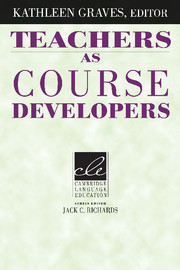Book contents
- Frontmatter
- Contents
- Contributors
- Series editor's preface
- Preface
- Acknowledgments
- 1 Teachers as course developers
- 2 A framework of course development processes
- 3 Designing workplace ESOL courses for Chinese health-care workers at a Boston nursing home
- 4 Designing a seventh-grade social studies course for ESL students at an international school
- 5 Designing an EAP course for postgraduate students in Ecuador
- 6 Designing a writing component for teen courses at a Brazilian language institute
- 7 Planning an advanced listening comprehension elective for Japanese college students
- 8 A curriculum framework for corporate language programs
- Further reading
- Index
3 - Designing workplace ESOL courses for Chinese health-care workers at a Boston nursing home
Published online by Cambridge University Press: 18 December 2009
- Frontmatter
- Contents
- Contributors
- Series editor's preface
- Preface
- Acknowledgments
- 1 Teachers as course developers
- 2 A framework of course development processes
- 3 Designing workplace ESOL courses for Chinese health-care workers at a Boston nursing home
- 4 Designing a seventh-grade social studies course for ESL students at an international school
- 5 Designing an EAP course for postgraduate students in Ecuador
- 6 Designing a writing component for teen courses at a Brazilian language institute
- 7 Planning an advanced listening comprehension elective for Japanese college students
- 8 A curriculum framework for corporate language programs
- Further reading
- Index
Summary
Johan Uvin, originally from Belgium, has extensive experience in workplace ESOL with immigrants in the Boston area. He has taught immigrants, worked in staff development, written proposals, and directed workplace literacy programs. He has managed workplace education grants and, since 1993, has supervised adult basic education development efforts for the Massachusetts Department of Education. In this chapter he gives us “a tale of two courses.” He designed and taught a course for Chinese health-care workers in Boston using the competency-based methods in widespread use at that time. He spent over ninety hours doing an exhaustive needs analysis that involved not only the students but also nursing staff, supervisors, patients, and administrators. He decided, how-ever, that even though the course did what it was designed to do, it had failed his students. In this chapter, he tells us why he felt this to be the case and how he radically redirected the course as a result.
The course development focus for this chapter is needs assessment. Consider the following questions as you read:
In this account of course development, who determined what the students' needs were? How were those needs defined?
Uvin describes two approaches to course design. In each approach, how were the students involved in determining needs?
In my third year as a teacher at the Chinese-American Civic Association (CACA), we received a grant from the U.S. Department of Education's National Workplace Literacy Program to provide a course for Chinese health-care workers at the South Cove Manor Nursing Home in Boston.
- Type
- Chapter
- Information
- Teachers as Course Developers , pp. 39 - 62Publisher: Cambridge University PressPrint publication year: 1996
- 4
- Cited by



